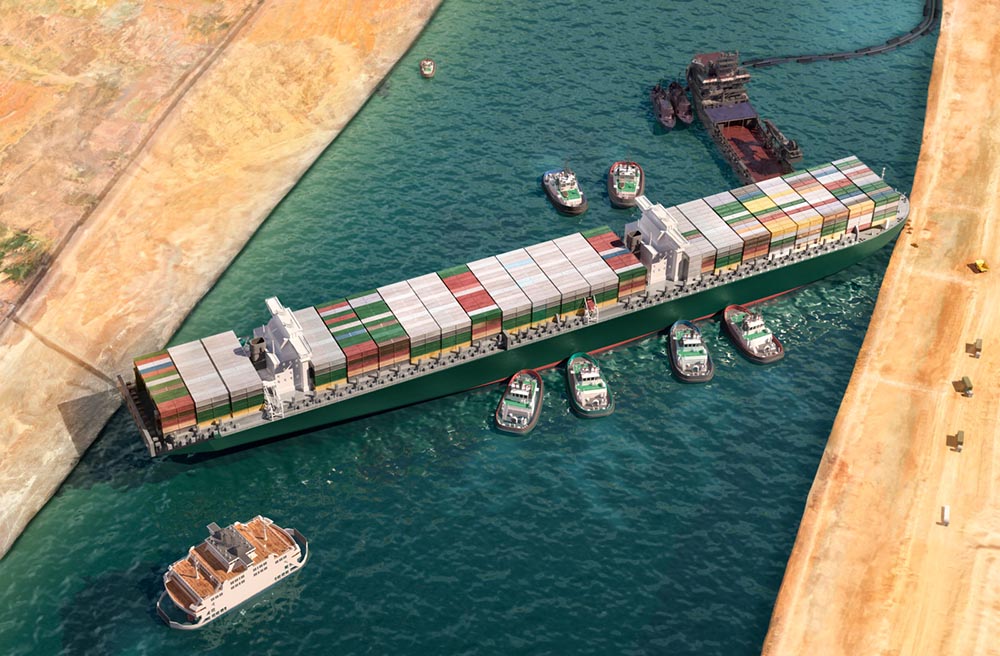The economic impact of climate change on ports
What do you do if the world’s busiest port shuts down due to poor weather conditions?
In September 2021, the port of Shanghai in China had to cease its operations due to the arrival of Typhoon Chanthu. The shutdown lasted two weeks and had an adverse impact on the global supply chain as the holiday season loomed ahead and shippers awaited the arrival of their goods at their respective destinations. Factor in the COVID-19 pandemic and labour shortages, any minute delays now have long-term supply chain implications. This was not the only affected port in the region – Ningbo-Zhoushan also had to take in safety precautions and close down terminals due to Typhoon Chantu. It had barely re-commenced functioning after a two week heist due to a COVID outbreak. At the time, it was estimated that $14 billion worth of trade would be disrupted.
Let’s not forget spring last year, when the mighty 200,000 metric-ton vessel Evergreen was run aground due to strong gusts of wind and blocked the strategic Suez Canal waterway for almost a week. For the Suez Canal port, it cost up to $14-$15 million in revenue per day and impacted thousands of businesses across the globe.

To put this into context, approximately 12% of international trade, 8% of liquefied natural gas and one million barrels of oil travel through the narrow waters of this important aqua channel each day.
The grounded vessel was blocking trade worth $9.6 billion a day.
That mounts to $6.7 million in cost per minute and sums up to $400 million per hour along with 3.3 million tonnes of cargo. The massive ship was freed six days later. Whilst other ships were rerouted around South Africa, it added a further eight days to their entire journey plus an additional cost of fuel consumption of $30,000.
This is not the end yet the beginning of the story. Canada’s largest port in Vancouver was cut off from all rail services due to flooding and landslides following rain storms that bombarded the Pacific Northwest and British Columbia in November 2021. As the tale goes with all port closures, major shipment delays and vessel congestion ensued.
Although these ports lie at different points on the world map yet have a compelling recurrent force connecting them: climate change.
Climate change could slash global GDP
It is predicted that the international economy could lose 10% of its value by 2050 due to climate change. The Swiss RE reported that the world’s GDP could diminish by 18% if international temperatures increase by 3.2°C. The frequency of weather incidents causing port closures have only grown over the past few years and will only worsen with the passage of time.
A study conducted by the National Center for Atmospheric Research with IH Cantabria illustrated that unless greenhouse gas emissions are decreased, by the year 2100, 90% of the ports included in the 2013 sample would be even more prone to weather risks.
From this number, 289 ports would be at a relatively higher risk to exposure. This can include overflooding of docks, on-loading & off-loading operations and rising temperatures.
It’s more imperative than ever for the maritime industry to have access to timely, reliable weather insights for effective ship arrival/departure schedules, cargo transfers, and labour and equipment planning. Fortunately, location-specific weather forecasts can aid ports to plan for a better future. If you’d like to understand how weather forecasts for ports can facilitate operations, have a read here.
Not all weather forecasts are created equal
The truth is that an immense chunk of the Earth is unobserved and causes gaps and uncertainties in the art of weather forecasting. Whilst specific parts of the globe can generate a consistent, authentic supply of weather observation data, other regions may not be able to match the same level of high quality and coverage.
Another barrier that the forecasting community faces is gaining verified ocean weather insights. The surface area of all oceans is 140 million square miles and the majority of it is too remote for wide-band communications. Other elements also interfere in the transmission process such as storms, saltwater and breaking waves. As we’re not able to access each and every point of the high seas, it becomes hard to accumulate a sufficient level of data to create accurate weather forecasts. It’s not just challenging to aggregate accurate weather observation data at the ground or ocean level – the atmosphere itself creates obstacles.
Now, it is clear that errors in weather forecasting occur as we don’t know what every small molecule in the atmosphere is up to. The truth is, even if we did, we don’t have the capacity to craft a complete digital twin of our entire planet. Not all is grey and gloomy. The good news is that now mankind has been able to reach the seven skies and has eyes from the best vantage point: from space.
Spire’s Port Optimised Forecast
Dedicated to facilitating the maritime industry to face the complex challenges of the modern world, constant innovation lies at the heart of Spire’s business model. As of January 2022, Spire Global has 150 satellites in orbit that are collecting millions of messages per day. As a one-stop weather and maritime insight hub, Spire will continue to provide more data and insights to provide more accurate and actionable weather forecasts for the maritime industry. Spire launched its Port Optimised Forecast that can help ports remain profitable despite the climatic events occurring.
If you’d like to learn more, schedule a call with one of our experts now!
 Written by
Written by


